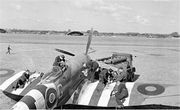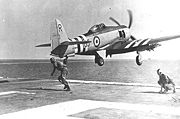
Invasion stripes
Encyclopedia

Fuselage
The fuselage is an aircraft's main body section that holds crew and passengers or cargo. In single-engine aircraft it will usually contain an engine, although in some amphibious aircraft the single engine is mounted on a pylon attached to the fuselage which in turn is used as a floating hull...
s and wings of World War II
World War II
World War II, or the Second World War , was a global conflict lasting from 1939 to 1945, involving most of the world's nations—including all of the great powers—eventually forming two opposing military alliances: the Allies and the Axis...
Allied
Allies of World War II
The Allies of World War II were the countries that opposed the Axis powers during the Second World War . Former Axis states contributing to the Allied victory are not considered Allied states...
aircraft, for the purpose of increased recognition by friendly forces (and thus reduced friendly fire
Friendly fire
Friendly fire is inadvertent firing towards one's own or otherwise friendly forces while attempting to engage enemy forces, particularly where this results in injury or death. A death resulting from a negligent discharge is not considered friendly fire...
incidents) during and after the Normandy Landings. The bands, consisting of three white and two black bands, wrapped around the rear of an aircraft fuselage just in front of the empennage
Empennage
The empennage , also known as the tail or tail assembly, of most aircraft gives stability to the aircraft, in a similar way to the feathers on an arrow...
(tail) and from front to back around both the upper and lower surfaces of the wings.
Stripes were applied to fighters, photo-reconnaissance aircraft
Reconnaissance aircraft
A reconnaissance aircraft is a manned military aircraft designed, or adapted, to carry out aerial reconnaissance.-History:The majority of World War I aircraft were reconnaissance designs...
, troop carriers, twin-engined medium
Medium bomber
A medium bomber is a bomber aircraft designed to operate with medium bombloads over medium distances; the name serves to distinguish them from the larger heavy bombers and smaller light bombers...
and light bomber
Light bomber
A light bomber is a relatively small and fast class of military bomber aircraft which were primarily employed before the 1950s. Such aircraft would typically not carry more than one ton of ordnance....
s, and some special duty aircraft, but were not painted on four-engined heavy bomber
Heavy bomber
A heavy bomber is a bomber aircraft of the largest size and load carrying capacity, and usually the longest range.In New START, the term "heavy bomber" is used for two types of bombers:*one with a range greater than 8,000 kilometers...
s of the U.S. Eighth Air Force or RAF Bomber Command
RAF Bomber Command
RAF Bomber Command controlled the RAF's bomber forces from 1936 to 1968. During World War II the command destroyed a significant proportion of Nazi Germany's industries and many German cities, and in the 1960s stood at the peak of its postwar military power with the V bombers and a supplemental...
, as there was little chance of mistaken identity—few such bombers existed in the Luftwaffe. The order affected all aircraft of the Allied Expeditionary Air Force
Allied Expeditionary Air Force
The Allied Expeditionary Air Force was a component of the Supreme Headquarters Allied Expeditionary Force which controlled the tactical air power of the Allied forces during Operation Overlord.Its effectiveness was less than optimal on two counts...
, the Air Defence of Great Britain
Air Defence of Great Britain
The Air Defence of Great Britain was a RAF command comprising substantial Army and RAF elements responsible for the air defence of the British Isles...
, gliders, and support aircraft such as Coastal Command air-sea rescue
Air-sea rescue
Air-sea rescue is the coordinated search and rescue of the survivors of emergency water landings as well as people who have survived the loss of their sea-going vessel. ASR can involve a wide variety of resources including seaplanes, helicopters, submarines, rescue boats and ships...
aircraft whose duties might entail their overflying Allied anti-aircraft defenses. To stop aircraft being compromised when based at forward bases in France, a month after D-Day stripes were ordered removed from the upper surfaces of airplanes, and completely removed by the end of 1944.
The use of recognition stripes was conceived when a study of the effects of thousands of aircraft using IFF
Identification friend or foe
In telecommunications, identification, friend or foe is an identification system designed for command and control. It is a system that enables military and national interrogation systems to identify aircraft, vehicles, or forces as friendly and to determine their bearing and range from the...
on D-Day concluded that they would saturate and break down the existing system. Air Chief Marshal
Air Chief Marshal
Air chief marshal is a senior 4-star air-officer rank which originated in and continues to be used by the Royal Air Force...
Sir Trafford Leigh-Mallory
Trafford Leigh-Mallory
Air Chief Marshal Sir Trafford Leigh-Mallory KCB, DSO & Bar was a senior commander in the Royal Air Force. Leigh-Mallory served as a Royal Flying Corps pilot and squadron commander during World War I...
, commanding the Allied Expeditionary Air Force, approved the scheme on May 17, 1944. A small scale test exercise was flown over the OVERLORD
Operation Overlord
Operation Overlord was the code name for the Battle of Normandy, the operation that launched the invasion of German-occupied western Europe during World War II by Allied forces. The operation commenced on 6 June 1944 with the Normandy landings...
invasion fleet on June 1, to familiarize the ships' crews with the markings, but for security reasons, orders to paint the stripes were not issued to the troop carrier units until June 3 and to the fighter and bomber units until June 4.
Marking description

In most cases the stripes were painted on by the ground crews; with only a few hours notice, few of the stripes were "masked". As a result, depending on the abilities of the "erks" (RAF nickname for ground crew), the stripes were often far from neat and tidy.
Operation Starkey
The stripes for this two-day deception operation in 1943 were black from the wing tip to a position on the wing where the chord is 5 feet, then four bands of alternating white and black. This was the same for the upper and lower surfaces. These were applied to all aircraft operating at low level. For single engine aircraft the stripes were 18 inches in width. For twin engine aircraft, including the Westland Whirlwind, the stripes were 24 inches in width.Hawker Typhoon

Hawker Typhoon
The Hawker Typhoon was a British single-seat fighter-bomber, produced by Hawker Aircraft. While the Typhoon was designed to be a medium-high altitude interceptor, and a direct replacement for the Hawker Hurricane, several design problems were encountered, and the Typhoon never completely satisfied...
and early production Hawker Tempest
Hawker Tempest
The Hawker Tempest was a British fighter aircraft primarily used by the Royal Air Force in the Second World War. The Tempest was an improved derivative of the Hawker Typhoon, and one of the most powerful fighter aircraft used during the war....
Mark Vs. The aircraft had a similar profile to the Focke-Wulf Fw 190
Focke-Wulf Fw 190
The Focke-Wulf Fw 190 Würger was a German Second World War single-seat, single-engine fighter aircraft designed by Kurt Tank in the late 1930s. Powered by a radial engine, the 190 had ample power and was able to lift larger loads than its well-known counterpart, the Messerschmitt Bf 109...
and the bands were added to aid identification in combat. The order was promulgated on 5 December 1942. At first they were applied by unit ground crews, but they were soon being painted on at the factory. Four 12 inches (304.8 mm) black stripes separated by three 24 inches (609.6 mm) white, underwing from the wingroots. From early 1943 the Typhoons also had a yellow, 18 inches (457.2 mm) stripe on each of the upper wings, centred on the inner cannon. All of these markings were officially abandoned 7 February 1944.
The Luftwaffe's Jagdverband 44
The late-war specialized all-jet LuftwaffeLuftwaffe
Luftwaffe is a generic German term for an air force. It is also the official name for two of the four historic German air forces, the Wehrmacht air arm founded in 1935 and disbanded in 1946; and the current Bundeswehr air arm founded in 1956....
fighter squadron, Jagdverband 44, possessed a number of Fw 190 D piston-engined fighters to protect their units' Messerschmitt Me 262
Messerschmitt Me 262
The Messerschmitt Me 262 Schwalbe was the world's first operational jet-powered fighter aircraft. Design work started before World War II began, but engine problems prevented the aircraft from attaining operational status with the Luftwaffe until mid-1944...
jet fighters during the jets' takeoff and landing operations, as the jets were most vulnerable to Allied piston-engined fighter attack at those times. The Fw 190D aircraft of this so-called Platzschutzstaffel (airfield protection detachment) used a solid red color scheme, with narrow white stripes, under the wings and central fuselage to identify them as "friendly" Luftwaffe fighters, for similar reasons as the "invasion stripes" had been used in Operation Overlord ten months earlier over Normandy.
Korea

United Kingdom
The United Kingdom of Great Britain and Northern IrelandIn the United Kingdom and Dependencies, other languages have been officially recognised as legitimate autochthonous languages under the European Charter for Regional or Minority Languages...
and Australia
Australia
Australia , officially the Commonwealth of Australia, is a country in the Southern Hemisphere comprising the mainland of the Australian continent, the island of Tasmania, and numerous smaller islands in the Indian and Pacific Oceans. It is the world's sixth-largest country by total area...
n Fleet Air Arm
Fleet Air Arm
The Fleet Air Arm is the branch of the British Royal Navy responsible for the operation of naval aircraft. The Fleet Air Arm currently operates the AgustaWestland Merlin, Westland Sea King and Westland Lynx helicopters...
aircraft operating during the Korean War
Korean War
The Korean War was a conventional war between South Korea, supported by the United Nations, and North Korea, supported by the People's Republic of China , with military material aid from the Soviet Union...
in 1950.
Similar stripes were also used early in the war on F-86 Sabres of the 4th Fighter Interceptor Wing.
Suez
The stripes were used again by the Royal Air ForceRoyal Air Force
The Royal Air Force is the aerial warfare service branch of the British Armed Forces. Formed on 1 April 1918, it is the oldest independent air force in the world...
, the Royal Navy's Fleet Air Arm
Fleet Air Arm
The Fleet Air Arm is the branch of the British Royal Navy responsible for the operation of naval aircraft. The Fleet Air Arm currently operates the AgustaWestland Merlin, Westland Sea King and Westland Lynx helicopters...
, and the French Air Force
French Air Force
The French Air Force , literally Army of the Air) is the air force of the French Armed Forces. It was formed in 1909 as the Service Aéronautique, a service arm of the French Army, then was made an independent military arm in 1933...
during the Suez operation
Operation Musketeer (1956)
Operation Musketeer was the Anglo-French-Israeli plan for the invasion of Egypt to capture the Suez Canal during the Suez Crisis. Israel had the additional objective to open the Straits of Tiran.-The operation:...
of 1956. Single-engined aircraft had yellow/black/yellow/black/yellow stripes one foot wide. The pattern was the same on multi-engined aircraft but the bands were two feet wide.

